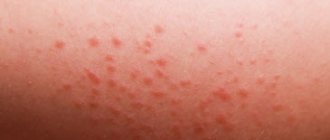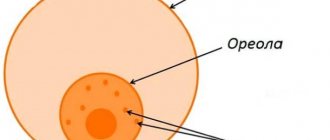Reasons for appearance
Only a professional can determine the true nature of the seal. There are factors associated with the appearance of cones. They are associated with damage to bone or soft tissue.
The main causes include:
- heredity;
- inflammatory process in the body;
- abscess due to infection;
- neglect of personal hygiene rules;
- clogging of the sebaceous glands;
- oncology;
- individual reaction of the body to injections;
- hypothermia;
- falls, bruises;
- poor nutrition.
Most subcutaneous formations are a harmless process, the lump does not hurt. Successful treatment is achieved by timely access to the hospital.
Sometimes swelling indicates a serious pathology of the body. The first thoughts arise about cancer. An anxious state appears. The likelihood of cancer is low, but the doctor rules it out.
Seals occur in both men and women. Often appear in adolescence, during pregnancy.
Treatment methods
The main way to combat tumors and lumps on the skin of the thigh is surgery (surgical intervention). After it is carried out, the person recovers completely, but it is necessary to monitor his condition, prescribe a course of medications (analgesics, anti-inflammatory drugs, antibiotics), give advice on adjusting lifestyle, nutrition, etc.
If the disease is benign, it is not dangerous and you can do without surgery. In such cases, therapy is carried out at home using folk remedies or medications prescribed by a doctor.
Types of subcutaneous tumors
The size of the cone, structure, and symptoms determine its name. Photos depict variations.
Atheroma
Atheroma on the inner side of the thigh is a cystic tumor-like compaction. According to statistics, the male population is more susceptible to the occurrence. Increased testosterone plays a role. Benign character.
The reason is blockage of the sebaceous glands. The formation is provoked by a bruise or hip injury. Improper metabolism and hormonal imbalances contribute to the appearance.
Signs of atheroma:
- oval, round shape;
- the skin is even in color, there is no redness;
- designated boundaries. You need to feel it to understand what it is. On palpation, a dense formation is felt, like a ball;
- mobile structure, has an unpleasant odor. The contents of atheroma are a substance produced by the sebaceous gland. Curdled consistency;
- interferes with movement;
- can reach 7 cm.
The neglected condition leads to an inflammatory process. Color, volume, structure changes. A white tint with a brown tint appears. Pus, blood, pain, and fever appear. The contents come out from the center of the tumor along with bacteria, microorganisms, fat, and hair debris.
Timely supervision by a specialist is necessary. In rare cases, transformation into a malignant lump is possible.
Atheroma often occurs closer to the groin. The area has hair follicles, sebaceous glands. A good environment for the proliferation of tumors.
Many factors contribute:
- increased sweating;
- trauma during intimacy;
- wearing tight underwear;
- infection of the groin area;
- failure to comply with hygiene rules;
- heredity;
- hormonal imbalance.
Atheroma is eliminated in the early stages with a laser. Quickly, painlessly in 20 minutes. The surgical method is often used. Removal occurs under local anesthesia. For many years, atheroma can remain small and does not cause concern, only a cosmetic inconvenience.
Nodes in the veins of the legs: treatment and its features
Treatment of nodes in the veins of the legs begins only after the patient has undergone a series of laboratory and instrumental examinations, the key of which is ultrasound duplex scanning of the vessels of the lower extremities.
Based on the results obtained, the phlebologist can judge the need for minimally invasive surgical intervention and the degree of its safety for the patient. Vein nodules in the leg can be eliminated under local anesthesia in several ways.
- Laser coagulation of a vessel, which involves introducing a special device into the cavity of a blood vessel and “welding” its walls with thermal radiation. Due to this, it stops filling with blood and is completely excluded from the bloodstream.
- Miniphlebectomy, the essence of which is the complete removal of the affected superficial vessels by removing them from the thickness of the tissue through small punctures.
Malignant tumors
Forewarned is forearmed. It is necessary to distinguish the primary signs of cancerous lumps on the body, despite their rarity:
- blurry, unclear contours of the bump;
- rapid growth of the lymph nodes of the groin;
- fusion with the skin, difficult mobility;
- formation of a compaction at the site of the mole;
- tumor bleeding.
Which doctor should I contact if I have a lump under the skin?
If any compaction is detected on the outer covering, it is important to inform a physician about this to obtain advice and prescribe appropriate treatment.
Specialists to contact:
- dermatologist (consultation, disease diagnosis);
- surgeon (surgical treatment of complicated cases);
- oncologist (to identify the possibility of a cancerous tumor, prescribe chemotherapy, etc.).
Any lump on the inner side of the thigh requires immediate consultation with a doctor to obtain accurate information about the pathology, methods of treatment and prevention. If you prevent the development of the anomaly in time, you can avoid serious consequences and a long recovery.
Diagnosis of seals
Finding subcutaneous phenomena in yourself is a reason to immediately visit the hospital. Lack of temperature is not an indicator to stay at home. You need to understand which doctor to see. The problem is solved by a dermatologist, surgeon, therapist. It is known that when malignant tumors were painless, the usual symptoms were absent. Rare cases. Unfortunately, the risk of cancer always exists.
The doctor performs a visual examination. Evaluates the color, size, structure of the formation, and the patient’s symptoms. One visit to the hospital is not enough. They will prescribe ultrasound diagnostics, x-rays, biopsies of subcutaneous phenomena, and microscopic examinations of the material. It is strictly prohibited to apply mechanical force on your own to avoid complications.
Lumps in the muscles of the arm
A sudden tightening in the muscles of the arm may be a sign of severe overstrain and stretching of individual fibers of the tendon, ligament or fascial tissue. When compaction is located deep in the muscle, as a rule, weakness occurs and the inability to perform certain actions. Doctor's help required.
To diagnose a disease that causes tightness in the muscles of the arm, various approaches are used. An X-ray image allows you to assess the condition of the bone tissue, exclude splintered fractures, bone cracks, deforming osteoarthritis, which are often provoked by excessive tension in nearby muscles. Ultrasound examination of soft tissues allows timely detection of tumor processes, areas of accumulation of lymphatic fluid and capillary blood. To assess the condition of blood vessels, angiography and duplex scanning are performed. The performance of muscle fiber is determined using electromyography.
Compaction in the muscles of the upper limb can be caused by damage to the nerve fiber:
- cervical osteochondrosis with radicular syndrome can provoke pain in any part of the arm;
- brachial plexitis is characterized by damage to one of the branches of innervation;
- cubital tunnel syndrome affects the ulnar nerve;
- Carpal tunnel syndrome or carpal valve syndrome causes pain and impaired mobility in the hand and fingers.
To make a correct diagnosis, you must seek medical help. In Moscow, you can make an appointment for a free appointment with an orthopedist and neurologist at our manual therapy clinic. Here you will be offered an initial examination, an accurate diagnosis and the provision of comprehensive information about the possibilities and prospects of treatment.
Treatment of muscle lumps
It is necessary to begin treatment of compactions in the muscles with a high-quality differential diagnosis. If the lump is a growing tumor, then you definitely need to consult an oncologist. Only with the help of histology can one determine whether this neoplasm is benign or malignant. Then the likelihood of inflammation of the lymph nodes and vasodilation is eliminated.
In case of true damage to muscle, tendon, ligament and fascial tissue, treatment can be carried out using manual therapy and physical therapy. For diseases that are accompanied by muscle fiber tension syndrome, treatment is primarily aimed at eliminating the causes that caused these diseases.
In our manual therapy clinic we use the following methods of influence:
- laser treatment is aimed at eliminating stagnation of lymphatic fluid and blood;
- osteopathy and massage - accelerating microcirculation processes in the lesion;
- reflexology – influence on biologically active points on the human body;
- therapeutic exercises and kinesiotherapy;
- traction traction of the spinal column;
- physiotherapy, etc.
You can schedule a free initial appointment at our manual therapy clinic. During the consultation, the doctor will find out why the tightness in the muscles occurred. Will give recommendations for treating the underlying disease.
What is a painful lump?
Examples of Painful Lumps
An atheroma, or dermal cyst, is a raised bump that forms when the sebaceous glands become damaged and clogged, and then fill with sebum, dead cells and skin tissue. But these formations are painless and grow slowly.
The painful lump is an abscess, boil, or carbuncle (cluster of boils). The main cause of these formations is staphylococcus bacteria, which penetrate the skin, leading to swelling, redness and pain. These symptoms can help differentiate between a cyst and an abscess or boil on the thighs.
When will the cyst go away?
A cyst is a painless lump that can appear on the skin in any part of the body. On the upper thigh they may feel like large peas under the skin. The main causes may be infection, clogged sebaceous gland and irritation.
This lump usually grows slowly, is painless and smooth to the touch. If it is not damaged or inflamed, it will disappear on its own without treatment. To relieve some of the symptoms, it needs to be drained, which should be done by a medical professional.
Lumps in the back muscles along the spine
Most often, muscle compaction along the spine is a typical clinical symptom of developing degenerative dystrophic disease of the cartilage tissue of the intervertebral discs (osteochondrosis). When it occurs, primary dehydration of the fibrous ring occurs, as a result of which the disc loses its shock-absorbing ability. There is a reduction in the distance between two adjacent vertebral bodies, which provokes compression of the radicular nerves. In order to compensate for this, the body provokes tension in the muscular frame of the back. Constant static tension leads to a tightness in the back muscle and it can be quite painful.
In official medicine, special pharmacological drugs – muscle relaxants – are used to relieve such muscle tension against the background of osteochondrosis. They really effectively relax muscle tissue. But in this case, repeated injury to the nerve fiber occurs.
Common causes in women
In women, hip bumps can form as a result of hormonal imbalances that occur during puberty and the menstrual cycle. They can also be caused by allergies to medications, body lotions, deodorants and other products.
Other causes include a vaginal yeast infection causing irritation and itching, improper shaving of the bikini area, wearing clothes that are too tight and poor body hygiene. Hives, sexually transmitted infections such as genital warts and cancer are possible causes of lumps on the inner thighs of women.











